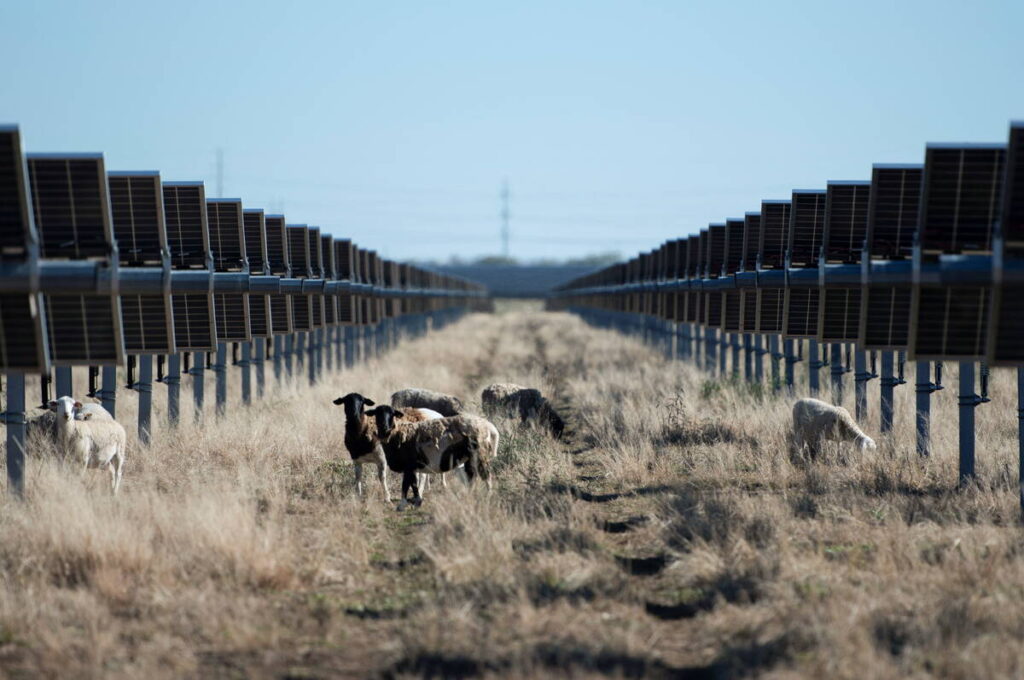U.S. farmers graze sheep under solar to survive

CHICAGO, Ill. (Reuters) — For the first time in four generations, the Raines family didn’t plant a single cotton seed last year. Chad Raines parked his tractor and rented out most of his Texas farmland to a neighbour.
Instead of plowing fields, Raines spent the year ferrying his flock of sheep to solar farms to munch on the grass that grows around the gleaming panels.
The deals he struck for this natural lawn-mowing service with five solar companies were more lucrative than growing cotton, he said.
Read Also


Red clover: A forage crop worth a second look
Red clover is a cool-weather crop. While alfalfa tends to yield better in southern regions, the trend shifts as you move north. Wisconsin forage expert Dan Undersander points out that this shift is noticeable even within his own state.
“Cotton prices have been terrible for so long, I had to do something different,” said Raines, 52.
As U.S. farmers grapple with soaring debt and slumping incomes, some crop producers are trading their tractors for flocks of sheep and starting up solar grazing businesses to help make ends meet.
Sheep herding for solar is one of the ways farmers are scrambling to diversify their income as a multi-year slump in the U.S. agricultural economy hits crop producers particularly hard, economists said.
If Raines had raised cotton last year, his farm would have seen a $200,000 loss, he said. Making money farming sheep only for meat would also be tough.
Instead, Raines cleared a profit of about $300,000, thanks to the solar sheep grazing payments and starting to sell lamb meat to a restaurant supplier, he said.
“Every expense I have, from the labour to the $2,000 a month I spend on dog food for the guard dogs, is covered by solar,” said Raines, whose son came back to the farm to help.
However, such opportunities may slow. U.S. president Donald Trump issued an executive order that, among other things, ends clean energy-related appropriated funds, which could impact a swath of clean energy incentives through the Inflation Reduction Act (IRA) in the future.
IRA funding has been frozen as part of the Trump administration’s sweeping push to review all government grants and loans. A court order earlier this year led to some IRA funds being unfrozen, but many groups have reported still being unable to access them.
“Farmers and ranchers should not have to rely on far-left climate programs for grazing land or ‘economic lifelines,’ ” a U.S. Department of Agriculture spokesperson said earlier this year, adding the department is focused on rural prosperity and “putting a stop to spending that has nothing to do with agriculture.”
U.S. cotton future prices have slumped nearly 40 per cent over the past two years as hefty global stocks overwhelmed global demand.
American exports have dropped sharply, losing out to cheaper Brazilian supplies and falling Chinese demand, USDA data shows.
“The last three years have been brutal for Texas cotton growers,” said Louis Barbera, a managing partner at cotton broker VLM Commodities.
While U.S. farm income overall is expected to improve this year, the upturn is being driven by high livestock prices and a massive boom in anticipated government aid from the American Relief Act of 2025, a USDA forecast in early February showed.
However, when adjusted for inflation, corn and soybean farm businesses will see incomes at the lowest levels since 2010, even if producers receive that aid, said Jennifer Ifft, an agricultural economist at Kansas State University.
Farmers who rely heavily on debt to operate were slower to pay back their loans in 2024, and a growing number are selling assets to stay afloat, according to data from Federal Reserve Banks of Kansas City and Minneapolis.
“Income diversification in ag downturns can mean saving the farm,” said Tait Berg, senior examiner and agricultural risk specialist at the Minneapolis Fed.
For farmers faced with pricey seed bills and expensive equipment parts for repairing their machinery, these solar land-management contracts can be an economic lifeline, according to Reuters interviews with more than a dozen farmers.
It can mean they run their farm at a profit rather than try to get a supplementary job in town to pay down their bills or find some other gig, they said.
Sheep grazed on more than 129,000 acres of U.S. solar panel sites last October, compared to 15,000 acres in 2021, according to the non-profit American Solar Grazing Association. The number of solar-site sheep jumped from 80,000 to more than 113,000 between January and October last year, the group said.
While that represents a tiny fraction of the nation’s total 5.05 million sheep and lamb herd, the new business opportunity has helped herd numbers tick higher for the first time since 2016, said Peter Orwick, executive director of the American Sheep Industry Association.
The U.S. solar industry grew under Trump’s first term, and development surged after a 2022 law passed under former president Joe Biden provided subsidies for new clean-energy projects, said Abigail Ross Hopper, president and chief executive officer of the Solar Energy Industries Association.
The sector expects to continue to grow under Trump’s second term, she said.
Said White House deputy press secretary Anna Kelly: “Ultimately, president Trump will cut programs that do not serve the interests of the American people and keep programs that put America First.”
In Indiana and Illinois, the solar boom has attracted 20- and 30-somethings eager to jump into farming without taking on millions of dollars in debt to rent land and machinery, industry analysts said.
In Virginia, Marcus and Jess Gray put their planting dreams on hold after securing lucrative contracts with Dominion Energy and Urban Grid. Now, they graze their 900-head flocks across 4,000 acres where solar is being built.
“It’s steady income, where we get to set and negotiate the price, rather than taking our grain from our bin to the local elevator and they tell us what it’s worth,” said Jess Gray, 39.
Using sheep for clearing local flora can mean substantial savings once a site is up and running.
The initial capital expenditures can be higher, depending on the project site, said Reagan Farr, CEO of Tennessee-based solar firm Silicon Ranch. Some locations require wells to be drilled for water supplies or more complex gating systems for corrals, he said.
Still, the company saves about 20 per cent in operating expenses once a site is running by using managed grazing, Farr said.
“The economics work when you’re not trucking a flock of sheep across the country or hauling in trucks of water,” Farr said. “It’s much easier and less costly to pay our shepherds a living wage than it is to hire someone to sit on a lawnmower for 10 hours a day, day in and day out.”
Demand for solar grazing animals prompted Silicon Ranch, in which Shell owns a stake, to launch its own sheep breeding program in Georgia to bolster local farmer supplies.
For Raines and his family, the decision was simple economics.
“If I had kept row crop farming, our family farm would be out of business,” he said.
Source: www.producer.com


